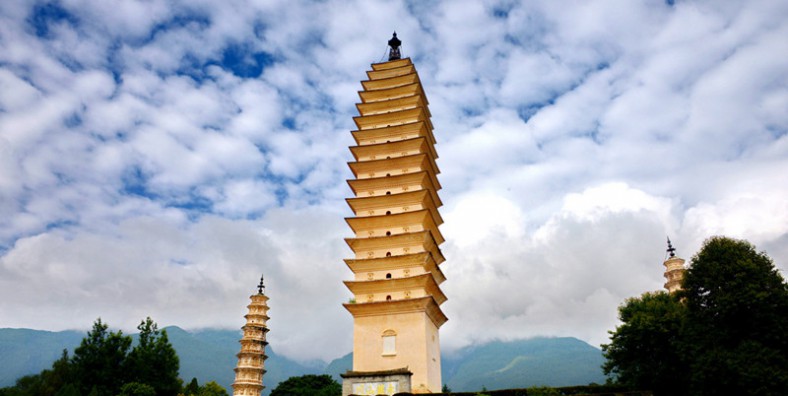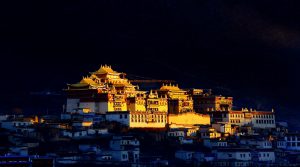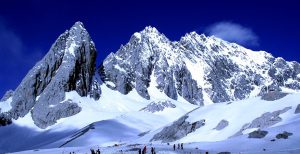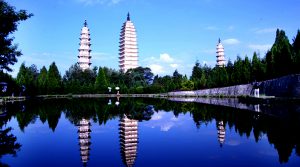16 Days Yunnan-Burma Overland Tour from Kunming to Yangon

Tour Overview
This tour arranges the overland tour form Yunnan to the neiboring countries. This Yunnan and Burma Old Road Tour will take you to visit Kunming,Shangri-La, Dali,Lijiang first, and then...
Code of Tour: CDT0000000869
Length of Travel: 16 Day
Destinations of Tour: Kunming-Shangrila-Lijiang-Dali-Baoshan-Tengchong-Ruili-Muse-Laoshio-Mandalay-Sagaing-Bagan-Yangon
Departure City: Kunming
Price of Tour: Request
Type of Tour: Private
Features of Tour: Nature Culture History Minority
This tour arranges the overland tour form Yunnan to the neiboring countries. This Yunnan and Burma Old Road Tour will take you to visit Kunming,Shangri-La, Dali,Lijiang first, and then drive to the western Yunnan-Burma border and visit Tengchong, Mangshi, Ruili. you will enter Myanmar from Ruili Border Gate.In myanmar, you will meet your tour guide and driver for your trip to Mandalay and Yangon. You will have a beautiful cruise tour in Irawady River. The Yunnan-Burma Road is a road linking Burma (also called Myanmar) with China. Its terminals are Kunming, Yunnan and Lashio, Burma. The road is 1,154 km long and runs through rough mountain terrian. The sections from Kunming to the Burmese border were built with no machine, only with hand tools by 200,000 Chinese laborers(women, children and old men, as young men all went to war) during the Second Sino-Japanese War in 1937 and completed by 1938.
Highlights:
- Visit Yunnan highlight citier—Kunming,Shangri-La, Dali,Lijiang.
- Cross Yunnan-Burma border and visit Tengchong, Mangshi, Ruili.
- Have a beautiful cruise tour in Irawady River
Brief Itinerary
- Day 1: Arrive Kunming
- Day 2: Kunming-Stone Forest-Kunming
- Day 3: Kunming-Shangri La
- Day 4: Shangri La-Tiger Leaping Gorge-Lijiang
- Day 5: Lijiang-Jade Dragon Snow Mountain-Lijiang
- Day 6: Lijiang – Dali
- Day 7: Dali
- Day 8: Dali-Tengchong
- Day 9: Tengchong
- Day 10: Tengchong- Mangshi- Ruili
- Day 11: Ruili – Muse – Lashio
- Day 12: Lashio – Pyin Oo Lwin
- Day 13: Pyin Oo Lwin – Mandalay
- Day 14: Mandalay – Amarapura–Mandalay-Yangon
- Day 15: Yangon
- Day 16: Departure from Yangon
Google Map
Detailed Itinerary
Day 1 Arrive Kunming
Sightseeing and Activities:
Accommodation: Kunming
Meals:
We’ll begin our journey to the diverse and captivating province of Yunnan from the capital city, Kunming. Upon arrival at the Kunming International Airport, our local guide will meet us. And then we will be transferred to our hotel.
–Kunming is well-known as the Spring City because of the nice climate all the year round. It is also the entrance to Southeast Asia countries. We can drive from Kunming to Laos, Vietnam and Burma directly.
Day 2 Kunming-Stone Forest-Kunming
Sightseeing and Activities: the Stone Forest, Kunming City Tour, the Green Lake, the Golden Horse and Phoenix Archway.
Accommodation: Kunming
Meals: Breakfast, Lunch

We will drive 86 km to the Stone Forest. There is a local saying: ‘It is a waste of time not to visit the Stone Forest while visiting Kunming’, which vividly expresses the deep love of the local people toward this world wonder. The quintessential karst landscape makes every tourist lost in wonder.
After lunch drive back Kunming ,we will take a leisurely stroll along the Green Lake, a charming area of teahouses and small boutiques selling handicrafts and beautiful local paintings. Late afternoon we will visit the Flower and Bird Market.
Day 3 Kunming-Shangri La
Sightseeing and Activities: the Ganden Sumtseling Monastery, the Bita Lake & Shudu Lake, the Old Town of Shangri La and the Guishan Park.
Accommodation: Shangri-la
Meals: Breakfast, Lunch

In the morning, we’ll visit the Ganden Sumtseling Monastery, the largest Tibetan monastery in Yunnan. And afterwards we’ll go and visit the tranquil Bita Lake & Shudu Lake. After having finished touring the Bita Lake & Shudu Lake, we’ll visit the Old Town of Shangri La and the Guishan Park.
Tibetan home made at night and have dinner in Tibetan family with butter oil tea and Tibetan food.
Day 4 Shangri La-Tiger Leaping Gorge-Lijiang
Sightseeing and Activities: the First Bend of the Yangtze River, Shigu Town, Tiger Leaping Gorge
Accommodation: Lijiang
Meals: Breakfast, Lunch

From Shangri-La, we’ll drive about 100KM to the Tiger Leaping Gorge, the deepest gorge in the world. With 34 rapids of the Yangtze River, it is called the Jinsha in this area because we can find gold in the river. Afternoon, we’ll head for Shangri La, the former Zhongdian. Upon arrival in Shangri La, we will have entered the Tibetan cultural area and a landscape of barley fields and yaks scattered in the valleys.
After lunch continue the driving 50KM more to visit the First Bend on the Yangtze River with imposing gorge scenery, and the Iron Chain Bridge in the Stone Drum town. The town of Stone Drum got its name from a large, cylindrical, marble tablet shaped like a drum. The scenery is magnificent as the road running through the Lijiang valley which is filled with wheat fields and drying haystacks.
Drive 60KM more to Lijiang. Explore Lijiang Old Town at night.
Day 5 Lijiang-Jade Dragon Snow Mountain-Lijiang
Sightseeing and Activities: Yulong Snow Mountain, Spruce Meadow, Baishui River, Baisha Village and Murals
Accommodation: Lijiang
Meals: Breakfast, Lunch

Enjoy the sunrise of the Jade Dragon Snow Mountain and Lijiang Ancient Town in the morning, drive about 30KM to Ganhaizi Meadow(3100M), you will take the sightseeig bus for a short visiting through the Baishuihe River, take the chairlift up to visit Jade Dragon Snow Mountain. The cableway will be arranged according to the condition of the mountain. You will hike around1 hours in the original forest in Spruce Meadow (3200M).
After lunch, you will enjoy the Impression Lijang Ethnic Show directed in Ganhaizi Meadow(3100M). A cultural show demonstrating the traditions and lifestyles of the Naxi, Yi and Bai peoples of the area. The show takes place inside Jade Dragon Snow Mountain Park at 3500m in an outdoor theater specifically designed to showcase the mountain which is used as a backdrop. The production itself was designed by Zhang Yimou, Fan Yue and Wang Chaoge, a cast of over 500 people, and a number of horses. In the afternoon, you’ll stroll through Baisha Village, which is an enchanting traditional Yunnan village. Visit the Baisha Mural about 600 years old, which is one part of the World Cultural Heritage by the UNESCO 1997.
–Jade Dragon Snow Mountain stretches a length of 35 kilometers (22 miles) and a width of 20 kilometers (13 miles). Looking from Lijiang Old Town in the south which is 15 kilometers (nine miles) away, the snow-covered and fog-enlaced mountain resembles a jade dragon lying in the clouds, hence, the name Jade Dragon Snow Mountain. The highest peak named Fan Peak (Shanzidou in Chinese) which is about 5596 meters above sea level. There are three cablecars in the mountain, the fist to the Glacier Park(4500M),the second to Spruce Meadow(3200M),the third to Yak Meadow(3700M).
Day 6 Lijiang – Dali
Sightseeing and Activities: Bai market,Butterfly Fountain, Three Pagodas
Accommodation: Dali
Meals: Breakfast, Lunch

After breakfast, travel (200 km – 4 hrs) south on the old road to the ancient city of Dali. If this day happens to fall on a Monday we will call in at Shaping for a visit to the colorful Bai market. Visit the Butterfly Fountain where hundreds of butterfly species in different sizes and colors flutter around.
After lunch, visit the honorable age-old Three Pagodas, symbolizing the outstanding architectural technology, the wisdom of the ancient laboring people and the brilliant culture of Dali. Enjoy some time in the restored city center.
Day 7 Dali
Sightseeing and Activities: the Erhai Lake Cruise, Xizhou Town, Zhoucheng Village and Bai Tie-Dyed Cloth Work Shop.
Accommodation: Dali
Meals: Breakfast, Lunch
In the morning, you’ll travel in the Erhai Lake by boat and visit Jinsuo Island. After landing, we will head for Xizhou Town to fully appreciate Bai-style architecture, taste their fragrant three-course tea and explore their distinctive culture. Visit Zhoucheng Town, and Bai people’s Tie-Dyed Cloth Work Shop.
Stay in Dali.
Day 8 Dali-Tengchong
Sightseeing and Activities: Heshun Old Town
Accommodation: Tengchong
Meals: Breakfast, Lunch
In the early morning we will drive about 5 hours to Tengchong. When we arrive in Tengchong, we will walk around Heshun Old Town; “Heshun” means peace and harmony. We could walk leisurely around the historical old town, built in earlier days by overseas Chinese as a location for their retirement. The remaining old town is a very beautiful place with many ornamental structures such as pavilions, memorial halls, archways, and balustrades, and also with lotus ponds and wetlands with many birds. The library in this town is worth mentioning-set up in 1924, it possesses over 60,000 volumes of books, many of which are rare editions of ancient works.
Day 9 Tengchong
Sightseeing and Activities: the Cemetery of World War II, Dieshuihe Waterfall Park and Rehai hotspring Park
Accommodation: Tengchong
Meals: Breakfast, Lunch
Special Experience: Enjoy the natural hot spring about three hours in Rehai.
After breakfast drive 15 minutes to the south-west and visit Heshun, a traditional walled in historical town. Heshun looks like out of an ancient Chinese picture book and is one of the most beautiful towns remaining in today’s China. Walk into town along the cobble stoned alleys up to the square where a small market is held everyday. Glance through some of the entrance gates into courtyards where residents trade their goods and wares.
Visit the Museum of Yunnan-Burmese Anti-Japanese War one of the most remarkable places of interest explaining the geopolitical importance of the Burma Road. Lunch at the Household Restaurant overlooking the pond in Heshun. And then visit the Cemetery of World War II, Dieshuihe Waterfall Park and Rehai hotspring Park. Overnight at hotel in Tangchong.
Day 10 Tengchong- Mangshi- Ruili
Sightseeing and Activities: Mangshi. Dai Style Buddhist architecture, the Tree-Wrapped-Pagoda and Wuyun Temple, the night market in Ruili.
Accommodation: Ruili
Meals: Breakfast, Lunch
It takes about 5 hours to drive first from Heshun to Mangshi. Visit Dai Style Buddhist architecture, the Tree-Wrapped-Pagoda and Wuyun Temple,
Enter further into the border area, where the region is getting richer on the trade. Road signs are multilingual in Chinese, Burmese, Dai as well as in English. Stop in little villages to visit the market activities and Buddhist temples. Explore the night market in Ruili.
Day 11 Ruili – Muse – Lashio
Sightseeing and Activities: the Chinese-Myanmar border –Jiegao, , Lashio Town
Accommodation: Lashio
Meals: Breakfast, Lunch
After breakfast, transfer to Jiegao, the Chinese-Myanmar border point, where you be welcomed by the Myanmar guide. After clearance of customs formalities enter into Muse. Proceed your trip (187 km – 5 hours) to Lashio, located at 855 meters in a mountain basin, where rain and clouds are unpredictable during the entire year. For the energetic, possibility to visit a typical village of the Palaung ethnic minority.
The town of Lashio still serves as rail head of the Burma Railway and used to be the starting point of the Burma Road until the Japanese invasion in 1941. We visit the Quan Yin San Temple, possibly the biggest Chinese style temple within Myanmar. We continue to Susana Pagoda and enjoy the nice view over Lashio and the surroundings. After that we drive to the Their Mingle Man Kiang Monastery. Of one of the monks in this monastery it is said that he is able to predict ones future quite accurately.
Day 12 Lashio – Pyin Oo Lwin
Sightseeing and Activities: Pyin Oo Lwin (Maymyo) town
Accommodation: Maymyo
Meals: Breakfast, Lunch
In the early morning, transfer to Lashio train station for the train to Pyin Oo Lwin. It take about 13 hours from Lashio to Pyin Oo Lwin for the train. At walking speed the train crosses the famous Gokteik Viaduct* that was built by American engineers in 1899 and spans over a 300m deep gorge. A truly fascinating experience. (Alternatively, this part of the trip can also be done by car). Mainly due to its cool climate, Maymyo, now officially called Pyin Oo Lwin, is located on a plateau about 1000m above sea level and served as summer capital during the British colonial era. The many beautiful, colonial style buildings, the broad avenus and the lovely botanical garden are still testimonies of the British presence in the area. (*Sometimes the train does not run for technical reasons. In this case we would have to drive straight to Maymyo).
Day 13 Pyin Oo Lwin – Mandalay
Sightseeing and Activities: the Mahamuni Pagoda; the Shwe Inbin Monastery; the Golden Palace Monastery, traditional hand-woven silk workshop
Accommodation: Mandalay
Meals: Breakfast, Lunch
We pay a visit to Kandawgyi Park, a lovely botanical garden which plans where laid out by Sir Harcourt Butler, a former Governor of Burma in 1915/16. We take a stroll through this magnificent garden and enjoy the relaxed atmosphere. Continue by horse cart for a visit to the big central market of Maymyo, passing many of the magnificent houses from the British colonial era. After lunch drive through a magnificent landscape towards Mandalay.
Day 14 Mandalay – Amarapura–Mandalay-Yangon
Sightseeing and Activities: Mahagandayon Buddhist monastery, Shwe Nan Daw Kyaung Monastery,U-Bein Bridge
Accommodation: Yangon
Meals: Breakfast, Lunch
The city of Mandalay is located on the banks of the Irrawaddy River and is the second largest city of Myanmar. Founded by King Mindon in 1857, Mandalay served as Myanmar’s capital until 1885 when, under British rule, the capital was moved to Yangon. In the morning we drive to Amarapura. Visit the Mahagandayone Monastery, which is home to over 800 monks and one of the most prestigious monasteries in Myanmar. Then visit to U-Bein Bridge, 1.2km long Bridge, was originally built in 1851 and is entirely made of teak wood. It is considered to be the longest teakwood bridge in the world.Continue to Shwe Nan Daw Kyaung, a magnificent wooden monastery dating back to 1879.Transfer to the Airport and flight to Yangon.
Day 15 Yangon
Sightseeing and Activities: the Shwedagon Pagoda,the Sule Pagoda and famous Scott Market
Accommodation: Yangon
Meals: Breakfast, Lunch
In the morning we enjoy one of the highlights of this trip – the Shwedagon Pagoda. The golden Stupa of the Shwedagon Pagoda is the ‘heart’ of Buddhist Myanmar. The Pagoda is believed to be 2,500 years old and the central stupa in surrounded by dozens of intricately decorated buildings and statues. There are always many Myanmar people praying and making offerings at Shwedagon, and it’s a fascinating place to spend time watching the world go by. Then we drive through the colonial style buildings downtown, the Chinatown area and the Indian quarter and pay a visit to the Sule Pagoda and famous Scott Market (except Mondays when the Scott Market is closed).
Day 16 Departure from Yangon
Sightseeing and Activities:
Accommodation:
Meals: Breakfast
You will be transferred to airport for departure.
Service Included:
- Admission fees for all of the sightseeing spots listed in the itinerary;
- Meals as listed in the itinerary;
- Hotels as listed in the itinerary;
- Private English-speaking tour guide;
- Private vehicle for transfers & sightseeing with skilled driver;
- Service charge & government taxes;
- Luggage transfers between airports and hotels;
Service Excluded:
- Any arrival and departure international airfares or train tickets;
- Chinese visa fees;
- Excess baggage charged by Airlines;
- Single room supplement;
- Tips to guides and drivers;
- Personal expenses and gratuities to service staff;
- Personal travel accident insurance;
- All optional programs.















